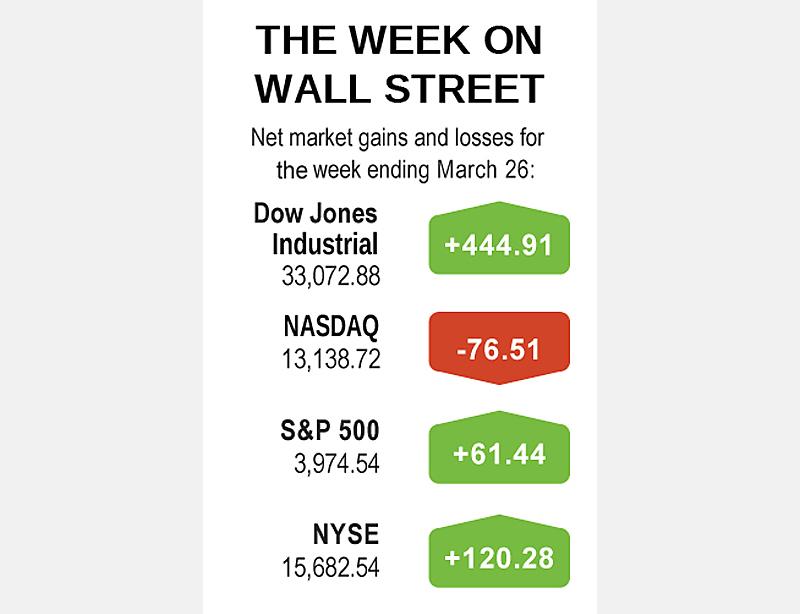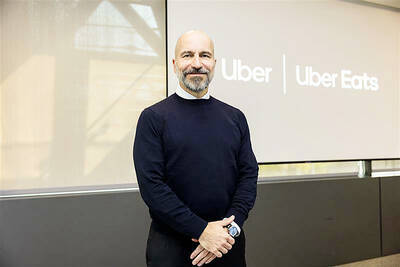The S&P 500 and Dow on Friday rose in a broad-based rally with technology, healthcare and financial stocks providing the biggest lift as investors bet on a recovery that is expected to deliver the fastest economic growth since 1984.
The S&P 500 and the Dow ended a seesaw week higher as investors rebalancing their portfolios at the quarter’s end continued to buy stocks that stand to benefit from a growing economy, while they added some beaten-down technology shares.
The NASDAQ also ended higher as less popular tech shares advanced, but posted its second weekly decline in a row.

Wall Street surged in the last half hour of trading, lifting all three indicies more than 1 percent. The S&P 500 and Dow eked out record closing highs.
The Russell 1000 value index, which includes energy, banks and industrial stocks, has gained more than 10 percent this year, outperforming its counterpart the Russell 1000 growth index, which is just above break-even for the year.
Some of the tech heavyweights slid, such as Tesla Inc and Google parent Alphabet Inc, but Microsoft Corp and Facebook Inc bucked the trend, helping lift the S&P 500 and NASDAQ higher.
“It is less a move out of technology than a move that evidences a broader appetite for equities to include both growth and value,” said John Stoltzfus, chief investment strategist at Oppenheimer Asset Management in New York.
The Dow Jones Industrial Average rose 453.4 points, or 1.39 percent, to 33,072.88. The S&P 500 gained 65.02 points, or 1.66 percent, to 3,974.54 and the NASDAQ Composite added 161.05 points, or 1.24 percent, to 13,138.72.
For the week, the S&P rose 1.57 percent and the Dow 1.36 percent, while the NASDAQ slipped 0.58 percent.
Volume on US exchanges was 12.23 billion shares, compared with the 13.67 billion average for the full session over the past 20 trading days.
The US Federal Reserve last week raised its GDP estimate for 2021 to 6.5 percent from 4.2 percent and many economists expect still faster growth, which has spurred fears the economy could run too hot and force the Fed to raise interest rates.
“It has been hard to restrain our US growth forecast in recent months. We’ve been upgrading our estimates almost as fast as we lowered them a year ago,” Carl Tannenbaum, chief economist at Northern Trust, told the Reuters Global Markets Forum.
Bank stocks gained 1.9 percent as the Fed said it would lift income-based restrictions on bank dividends and share buybacks for “most firms” in June after its next round of stress tests.
The yield on benchmark 10-year US Treasury notes rose to 1.66 percent, lower than a spike last week to 1.75 percent that sparked a sell-off on inflation fears and a potential Fed rate hike — something the Fed has pledged not to do.
The market is concerned that all of a sudden the Fed is forced to tighten against its repeated mantra that it will not, State Street Global Markets senior global macro strategist Marvin Loh said.
“The real concern is that things overheat and the Fed might be forced to change its mind,” he said.
Energy stocks jumped 2.6 percent, tracking a boost in crude prices after a giant container ship blocking the Suez Canal spurred fears of a supply squeeze.
Ten of the 11 major S&P sectors rose, with only the communication services index in the red.
Advancing issues outnumbered declining ones on the NYSE by a 3.3-to-1 ratio; on NASDAQ, a 1.81-to-1 ratio favored advancers.
The S&P 500 posted 65 new 52-week highs and no new lows; the NASDAQ Composite recorded 82 new highs and 51 new lows.

CHIP RACE: Three years of overbroad export controls drove foreign competitors to pursue their own AI chips, and ‘cost US taxpayers billions of dollars,’ Nvidia said China has figured out the US strategy for allowing it to buy Nvidia Corp’s H200s and is rejecting the artificial intelligence (AI) chip in favor of domestically developed semiconductors, White House AI adviser David Sacks said, citing news reports. US President Donald Trump on Monday said that he would allow shipments of Nvidia’s H200 chips to China, part of an administration effort backed by Sacks to challenge Chinese tech champions such as Huawei Technologies Co (華為) by bringing US competition to their home market. On Friday, Sacks signaled that he was uncertain about whether that approach would work. “They’re rejecting our chips,” Sacks

NATIONAL SECURITY: Intel’s testing of ACM tools despite US government control ‘highlights egregious gaps in US technology protection policies,’ a former official said Chipmaker Intel Corp has tested chipmaking tools this year from a toolmaker with deep roots in China and two overseas units that were targeted by US sanctions, according to two sources with direct knowledge of the matter. Intel, which fended off calls for its CEO’s resignation from US President Donald Trump in August over his alleged ties to China, got the tools from ACM Research Inc, a Fremont, California-based producer of chipmaking equipment. Two of ACM’s units, based in Shanghai and South Korea, were among a number of firms barred last year from receiving US technology over claims they have

BARRIERS: Gudeng’s chairman said it was unlikely that the US could replicate Taiwan’s science parks in Arizona, given its strict immigration policies and cultural differences Gudeng Precision Industrial Co (家登), which supplies wafer pods to the world’s major semiconductor firms, yesterday said it is in no rush to set up production in the US due to high costs. The company supplies its customers through a warehouse in Arizona jointly operated by TSS Holdings Ltd (德鑫控股), a joint holding of Gudeng and 17 Taiwanese firms in the semiconductor supply chain, including specialty plastic compounds producer Nytex Composites Co (耐特) and automated material handling system supplier Symtek Automation Asia Co (迅得). While the company has long been exploring the feasibility of setting up production in the US to address

OPTION: Uber said it could provide higher pay for batch trips, if incentives for batching is not removed entirely, as the latter would force it to pass on the costs to consumers Uber Technologies Inc yesterday warned that proposed restrictions on batching orders and minimum wages could prompt a NT$20 delivery fee increase in Taiwan, as lower efficiency would drive up costs. Uber CEO Dara Khosrowshahi made the remarks yesterday during his visit to Taiwan. He is on a multileg trip to the region, which includes stops in South Korea and Japan. His visit coincided the release last month of the Ministry of Labor’s draft bill on the delivery sector, which aims to safeguard delivery workers’ rights and improve their welfare. The ministry set the minimum pay for local food delivery drivers at